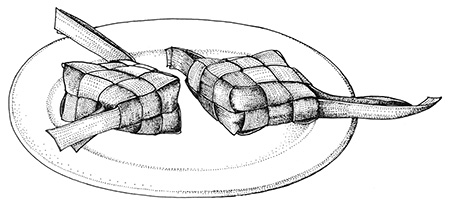Marking time in May 2020
Gado gado
In this time of social distancing, my friend Jo Bragg has set up a fundraiser and invited me to Create Gado Gado and Fight COVID 19.
Join us on Saturday 2nd May to create, decorate and digitally enter your own Indonesian Gado Gado, Crazy smoothie or other Indonesian favourite. Donate to Oxfam’s emergency appeal to enter and fight COVID 19. Why? To help protect our neighbours in Indonesia and elsewhere with needed hygiene equipment. Prizes will be given for best entries based on authenticity and creativity.
I have eaten many versions of gado gado, but the best of them was my first, in Bali in 1972. I remember it well. I don’t want to try to recreate that first experience—that would risk adulterating the memory.
I was staying in the village of Kuta, a short bémo ride south west from Denpasar. Foreign backpackers had started coming to Kuta and staying, as I did, in rooms added to some of the local family house compounds, or in one of the few small guest houses. You could eat excellent local food, and buy batik and ikat sarongs and other clothes necessary for visiting temples, and observe the people and the landscape. We backpackers brought money into the village, but our presence did not seem to disrupt the Balinese way of life—rice cultivation, fishing, animal raising, and the rich patterns of observance of temple obligations, all continued.
In 1991 I visited Kuta again (with my partner Margie this time) and found the place had changed. What I remembered from 1972 as a dirt foot path meandering through a grove of coconut trees had turned into a paved road clogged with buses and taxis and crowded with tacky bars and shops. I look at a google map of Kuta now, and I know I won’t be going back there…
Enough of that. Let me return to that gado gado of almost fifty years ago. I’ll need to bring in some Indonesian words to evoke the scene:
Warung—a kind of eating place, smaller and simpler than a restoran or rumah makan, and more than a roadside food cart. In my memory this particular warung had a wooden table with a couple of stools for diners to sit on, and space for the proprietor to prepare food, under the shade of a thatched roof. It was close to the beach, beside the road leading from the village to the seashore.
Wayan—a person’s name signifying that they are the first-born child in their family; also the name of the young woman in charge of the warung. Gado gado was the main item on her menu (or perhaps the only one, I don’t remember), and this is how she made it:
Sambal—the sauce. Wayan began by grinding fresh chillis (cabé rawit = bird pepper) and fried peanuts (kacang tanah) in a stone mortar that had the form of a flattish dish rather than the usual bowl shape. She mixed in some water to adjust the thickness of the sambal.
Lontong—pieces of cold cakes of compressed rice were the main ingredient of the dish by volume. These rice cakes had been made in advance, and were hanging under the thatched roof. Each cake was pillow-shaped, enclosed in a little basket of woven strips of coconut palm leaf. As Wayan made my gado gado her younger sister was making the next batch of these baskets, deftly twirling loops of leaf in one direction, then weaving another strip through them at right angles, then drawing the weave together to leave no gap a grain of rice could pass through, except for a small opening at one corner—uncooked rice was put through this opening, partly filling the container, then the package was pulled tight with a hanging loop protruding from the corner. When the packets were put into a pot of boiling water, the rice grains swelled into a solid mass within the palm leaf packet, ready for the next day’s gado gado.

With her sharp knife Wayan cut the lontong packets open, threw away the (bio-degradable) packaging and sliced the rice cakes into pieces and put them on my plate.
Tahu—slices of soybean curd (tofu) came next.
Sayuran—vegetables. There probably were some greens but I don’t remember what they were. The list of ingredients in my notebook has a cryptic ‘etc.’ which I now guess included various lightly-cooked vegetables served cold.
Taugé—Bean sprouts brought crisp textures to the dish.
Telur—egg. Small bantam-sized eggs, hard-boiled, shelled, and quartered, went in next, accompanied by distant crowing of bantam cocks, the wind in the coconut trees, and the swish of waves on the beach, followed by the sambal, and all the contents of the plate were mixed together to merge the sambal with the other flavours and textures.
Finishing touches—whole crisp-fried peanuts were sprinkled on top, along with Ikan bilis (tiny, intense, salty, dried anchovies) and a few Kerupuk (brightly-coloured fried prawn crackers kept in a large glass jar with airtight lid to keep them crisp) topped the dish.
Wayan handed the plate to me, with an aluminium spoon, with a smile and a hint of a bow. Salamat makan!